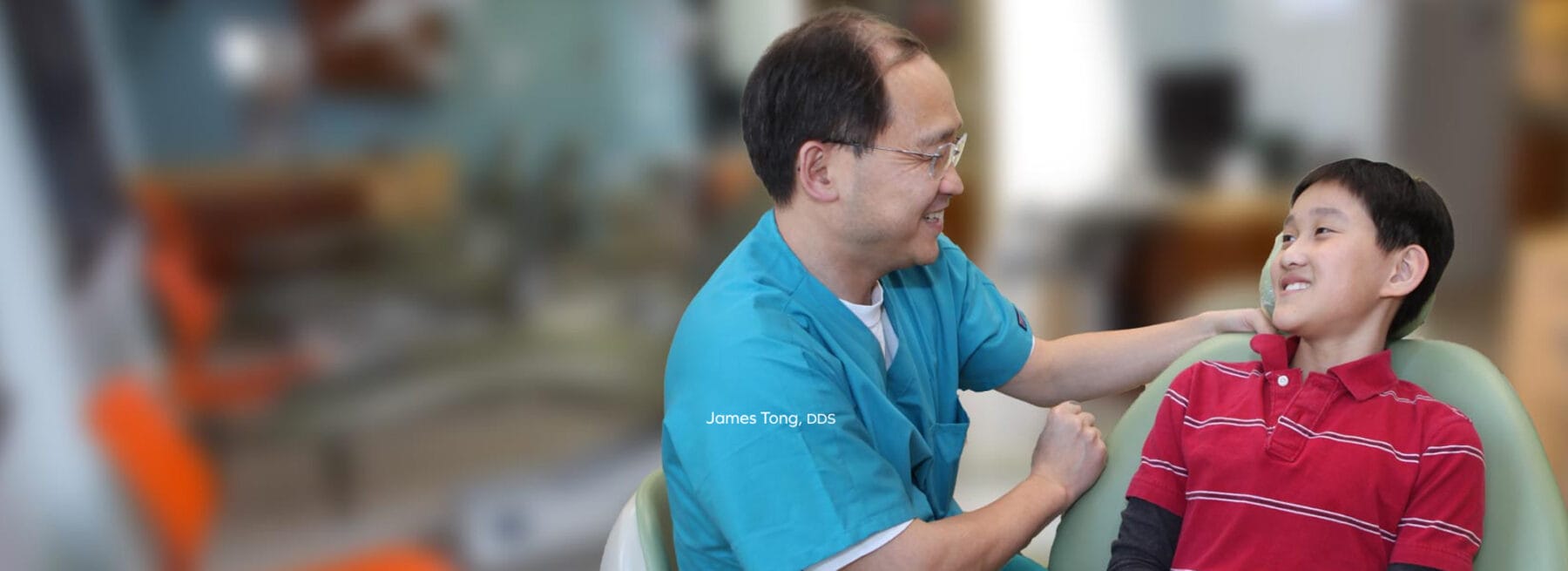

Tong Dental Care
Pediatric Dentist Gaithersburg, MD
Dr. James Tong has over 30 years of experience as a pediatric dentist in Gaithersburg, MD.
Kids
Our Pediatric Dental Care in Gaithersburg Offers A Lifetime of Smiles
Your children’s smiles are in the best hands at Tong Dental Care, the leading pediatric dentist in Gaithersburg, MD. We keep kids happy and healthy by focusing on providing exceptional service to promote bigger, brighter smiles. As the leading dentist in Gaithersburg, MD, our goal is to provide a pleasant and positive experience for both you and your children while focusing on your specific needs.
We use only the latest evidence-based procedures to achieve long-lasting results, and we encourage parents to promote a positive attitude towards dentistry and healthy dental habits for the whole family!

Specializing in Children
Dr. James Tong specializes in children; he spent an additional two years after becoming a dentist specializing in pediatric care. Pediatric dentistry is a dental specialty focused on preventing, diagnosing, and treating oral health problems in children. Pediatric dentists have specific training that qualifies them to care for children’s teeth and gums as they change throughout childhood. Pediatric dentists provide comprehensive dental services, from preventative treatment like cleanings and sealants to treatment for oral disease and injuries. A pediatric dentist will also counsel parents about a child’s nutritional and hygienic habits.
Your Kid’s Cleaning & Exams
Dental Cleanings (dental prophylaxis) are essential to preventing gum disease and decay, paving the way to a healthy smile. In a professional cleaning Dr. Tong, or his hygienist, will:
Remove debris that has built up on the teeth, called Plaque, and above the gum line, called Calculus (Tartar), both irritate the gums and cause decay. Plaque is a sticky substance that forms in the mouth from food, saliva, and bacteria. Plaque sticks to teeth and causes tooth decay and gum disease. Calculus is a plaque that has hardened on the tooth surface and is difficult to remove. (Calculus below the gum line indicates gum disease and requires a different procedure for removal)
Polish and remove stains from teeth.
Apply fluoride to strengthen teeth and prevent cavities.
Give hygiene instructions to improve your child’s brushing and flossing habits during home care.


Sealants and Fillings
Normal pits and grooves on the chewing surfaces of back teeth can trap food that can’t be removed by brushing or washed out by water or saliva. A sealant is a tough, plastic material designed to bond (stick) to tooth enamel.
Composite fillings are more than just attractive. They require minimal tooth preparation, in other words, a less healthy tooth structure is removed to restore the tooth. Also, a sealant can be placed over the remaining exposed grooves of the tooth to minimize the risk of decay on another area of the tooth.
Sedation Dentistry
We understand that for some patients, a dental visit can make them nervous, that is why we offer conscious sedation and nitrous oxide to our patients. With the help of prescription medication, our patients are calmed of their anxieties, making the visit comfortable and carefree.


Laser Dentistry with Tong
Not everyone likes to get numb. Not even the doctors. Laser and air abrasion dentistry is the newest and most effective technique that offers more flexibility, comfort, and precision than traditional drills. We utilize this technique in numerous treatments and its pinpoint accuracy provides better care by our skilled team.
Crowns for Children
A crown (often called a cap) covers the tooth and restores it to its original shape and size. Decay is removed and cleaned from the tooth, and a preformed crown is placed over it. Unlike adult crowns, in which the crown is made to fit the tooth and requires two appointments, baby crowns are placed in one visit because the tooth is prepared to fit the crown.


Pulpotomy
(Baby Root Canal)
The Problem:
Decay that has reached the nerve/pulp of the baby tooth.
The Solution:
Like adult root canals, the dentist will access the nerve chamber of the tooth, and remove some of the nerve/pulp of the tooth. Unlike adult root canals, this is a very short procedure, as only part of the pulp needs to be removed, and does not require the time-consuming filing of adult root canals.
Advantages:
If the tooth has been symptomatic this procedure will likely alleviate the pain. This allows for the tooth to be preserved until it is ready to fall out naturally.
Disadvantages:
Pulpotomies have a 90% success rate. Occasionally, the nerve of the tooth is so badly damaged that it does not respond to pulp therapy, resulting in the need for extraction of the offending tooth. Certain circumstances increase the likelihood of failure with pulpotomies, your dentist will discuss your child’s situation with you during diagnosis.
Alternatives:
The only alternatives to pulpotomy are extraction and the placement of a space maintainer. However, if it is possible to save the baby’s tooth, this is the best alternative because it preserves the appropriate spacing for the adult dentition.
Don’t wait — visit our pediatric dentist in Gaithersburg, MD, today!
Dental Emergency
There’s little that’s as painful as a tooth or jaw ache, so call us any time to schedule an emergency appointment. Our emergency dentist in Gaithersburg wants what’s best for you, so call us today for an emergency appointment!
Frequently Asked Questions
About Pediatric Dentistry
Hours
| Mon | 8:00 am – 5:00 pm |
| Tue | 8:00 am – 5:00 pm |
| Wed | 8:00 am – 5:00 pm |
| Thu | 8:00 am – 5:00 pm |
| Fri | 8:00 am – 5:00 pm |
| Sat | 8:00 am – 2:00 pm |
| Sun | Closed |
Services




